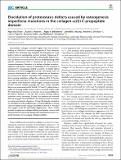Notice
This is not the latest version of this item. The latest version can be found at:https://dspace.mit.edu/handle/1721.1/134069.2
Elucidation of proteostasis defects caused by osteogenesis imperfecta mutations in the collagen-α2(I) C-propeptide domain
| dc.contributor.author | Doan, Ngoc-Duc | |
| dc.contributor.author | Hosseini, Azade S | |
| dc.contributor.author | Bikovtseva, Agata A | |
| dc.contributor.author | Huang, Michelle S | |
| dc.contributor.author | DiChiara, Andrew S | |
| dc.contributor.author | Papa, Louis J | |
| dc.contributor.author | Koller, Antonius | |
| dc.contributor.author | Shoulders, Matthew D | |
| dc.date.accessioned | 2021-10-27T19:57:55Z | |
| dc.date.available | 2021-10-27T19:57:55Z | |
| dc.date.issued | 2020 | |
| dc.identifier.uri | https://hdl.handle.net/1721.1/134069 | |
| dc.description.abstract | © 2020 Doan et al. Intracellular collagen assembly begins with the oxidative folding of ~30-kDa C-terminal propeptide (C-Pro) domains. Folded C-Pro domains then template the formation of triple helices between appropriate partner strands. Numerous C-Pro missense variants that disrupt or delay triple-helix formation are known to cause disease, but our understanding of the specific proteostasis defects introduced by these variants remains immature. Moreover, it is unclear whether or not recognition and quality control of misfolded C-Pro domains is mediated by recognizing stalled assembly of triple-helical domains or by direct engagement of the C-Pro itself. Here, we integrate biochemical and cellular approaches to illuminate the proteostasis defects associated with osteogenesis imperfecta-causing mutations within the collagen-a2(I) C-Pro domain. We first show that “C-Pro-only” constructs recapitulate key aspects of the behavior of full-length Cola2(I) constructs. Of the variants studied, perhaps the most severe assembly defects are associated with C1163R C-Proa2(I), which is incapable of forming stable trimers and is retained within cells. We find that the presence or absence of an unassembled triple-helical domain is not the key feature driving cellular retention versus secretion. Rather, the proteostasis network directly engages the misfolded C-Pro domain itself to prevent secretion and initiate clearance. Using MS-based proteomics, we elucidate how the endoplasmic reticulum (ER) proteostasis network differentially engages misfolded C1163R C-Proa2(I) and targets it for ER-associated degradation. These results provide insights into collagen folding and quality control with the potential to inform the design of proteostasis network-targeted strategies for managing collagenopathies. | |
| dc.language.iso | en | |
| dc.publisher | Elsevier BV | |
| dc.relation.isversionof | 10.1074/JBC.RA120.014071 | |
| dc.rights | Creative Commons Attribution 4.0 International license | |
| dc.rights.uri | https://creativecommons.org/licenses/by/4.0/ | |
| dc.source | Journal of Biological Chemistry | |
| dc.title | Elucidation of proteostasis defects caused by osteogenesis imperfecta mutations in the collagen-α2(I) C-propeptide domain | |
| dc.type | Article | |
| dc.relation.journal | Journal of Biological Chemistry | |
| dc.eprint.version | Final published version | |
| dc.type.uri | http://purl.org/eprint/type/JournalArticle | |
| eprint.status | http://purl.org/eprint/status/PeerReviewed | |
| dc.date.updated | 2021-07-23T16:56:24Z | |
| dspace.orderedauthors | Doan, N-D; Hosseini, AS; Bikovtseva, AA; Huang, MS; DiChiara, AS; Papa, LJ; Koller, A; Shoulders, MD | |
| dspace.date.submission | 2021-07-23T16:56:25Z | |
| mit.journal.volume | 295 | |
| mit.journal.issue | 29 | |
| mit.license | PUBLISHER_CC | |
| mit.metadata.status | Authority Work and Publication Information Needed |
